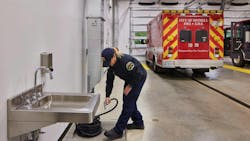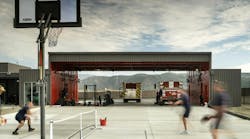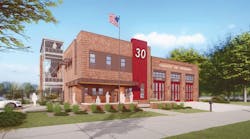5 things you probably didn’t know about fire station design
This blog post was authored by Zubin Rao, AIA, Associate, Miller Hull.
1. Fire Stations Should Inspire Communities
As durable pieces of life-saving civic infrastructure, fire stations should be designed to both reflect the values of the communities they serve; and enhance the quality, character, and inclusivity of those neighborhoods. When designing a fire station, we carefully study options for site organization, building massing, materiality, and public art integration to create facilities that are not just safe and operationally robust, but that also meaningfully and conceptually connect the fire service to the community.
As an example, in our Seattle Fire Station 31 project that just started construction, we are using charred wood cladding as the primary exterior material to fit the residential aesthetic character of the neighborhood while referencing the act of controlled burning as a way to honor the work of firefighters. Additionally, we worked with the Office of Arts and Culture and artist Damon Brown to integrate an approximately 14’ high by 70’ long byzantine glass mosaic into the primary façade of the building. The mural draws inspiration in its forms and colors from the people, plants, buildings, and history of the Northgate neighborhood that the station serves. I hope that as we find more opportunities to thoughtfully integrate the work of others into our projects. we create moments in which a community member might see something of themselves in a public building in a way they haven’t before.
2. Fire Stations Are Places of Learning and Training
Firefighting can be an extremely demanding and fast-paced profession. To keep certifications current, firefighters continually rehearse basic skills and complete continuing education activities to learn new techniques and best practices. Additionally, firefighters complete daily physical training regimens to maintain top strength and endurance. Fire stations often need to support these activities to minimize the time and expense involved with travelling to off-site dedicated training facilities.
When designing fire stations. we look for opportunities to include features like classroom spaces, computer terminals for self-study, dedicated hardened walls for practicing ladder work, and modern workout facilities. Currently, we are partnered with BNBuilders and MWStudios, a nationally-recognized leader in firefighter training facilities, to design a new home for the Firefighter and Emergency Medical Technician programs at Bates Technical College in Tacoma. Although still early in design, we have enjoyed bringing together our higher-education and fire station expertise in a single project. We’ve also enjoyed learning from our partner architect the ins and outs of arranging props and designing burn buildings to create realistic training scenarios for students. We look forward to bringing this enhanced understanding of Firefighter I and Firefighter II curriculum and essential training activities back into future station designs.
3. Fire Stations Are Optimized for Speed
Our fire department clients are keen to remind us that when responding to a call, the one variable they can control is how quickly they are able to leave the station, so it is critical that we look at every step in their response sequence to shave every second we can.
Starting at the scale of the site, we typically first identify the best position for the apparatus bays, ensuring that rigs have quick and direct access to an arterial road. We then plan the rest of the facility around the bays, ensuring walking paths inside the building are as straight and as short as possible, and that the most frequently occupied spaces are closest to the rigs. We also sweat little details like the location of switches, maps, and dispatch computers, and incorporate special features such as fast-acting bifold garage doors and lighting designs that are coordinated with alerting systems to visually signal incoming calls to the crews.
4. Fire Stations are Designed for Health
Firefighters face an increased risk of developing certain types of cancers due to exposure to carcinogens that are present in products of combustion, chemicals in protective gear, and diesel fumes produced by apparatuses (see here for a good intro). Accordingly, it is critical to minimize the degree and duration of exposure by designing stations that provide healthy indoor air quality and support the operational best practices codified in the Washington State Council of Fire Fighters’ “Healthy In, Healthy Out” manual.
By carefully arranging dedicated areas for decontamination (“red zones”), areas for gear storage (“yellow zones”), and areas for daily crew living and working (“green zones”) into logical, progressive workflows, the facilities themselves can continually reinforce firefighter awareness around taking every measure possible to maintain a clean working environment and limit their exposure.
More detailed features might include dedicated hand wash and boot wash stations directly near the doors of the apparatus bay to encourage washing every time a firefighter leaves the bays to go back into the clean side of the station. Further, specialty ventilation and dehumidification systems are provided in the red and yellow areas of the station to ensure airborne contaminants are effectively exhausted from the building, while green areas are positively pressurized to ensure dirty air cannot migrate into clean areas. We specify finishes throughout our stations that are nonporous, highly cleanable, and free of any toxic materials.
5. Fire Stations are Going Electric
Ecologically-minded states and municipalities are increasingly mandating that new public buildings be designed to not ever require fossil fuel use, and fire stations are no exception. In addition to using all electric appliances and providing hot water and space heating via heat pump-type systems, many stations will soon house electric rigs as well. Currently being tested in-service at just a handful of locations around the world, electric fire engines such as the Pierce Volterra will bring large electrical charging needs to fire facilities.
On our Seattle Fire Station 31 project, which itself will be fossil-fuel free, we also sized the electrical service to provide the ability to charge an all-electric fleet in the future. While the resulting service is approximately three times larger than a similarly-sized station with natural gas heating and no provisions for electric rigs, the ecological benefit and long-term operational savings can be well worth the higher initial cost and challenges of planning around significantly larger electrical equipment.
About the Author
Miller Hull
The Miller Hull Partnership, LLP is an internationally recognized architecture, planning, urban and interior design firm that works to create a regenerative and inclusive future through the built environment. Since its founding in 1977, Miller Hull has been designing dynamic and environmentally responsible buildings that provide enduring value for their communities. The firm has a studio in Seattle and San Diego with work extending across multiple typologies for a range of public and private clients where people Live, Work, Learn, Gather and Serve. Widely recognized for innovative, timeless designs and a partnership-driven practice, Miller Hull has received over 350 local, regional, national, and international awards for design excellence, including the American Institute of Architects Firm Award and Architect 50’s Top Firm for Sustainability. For more information, please visit www.millerhull.com.


